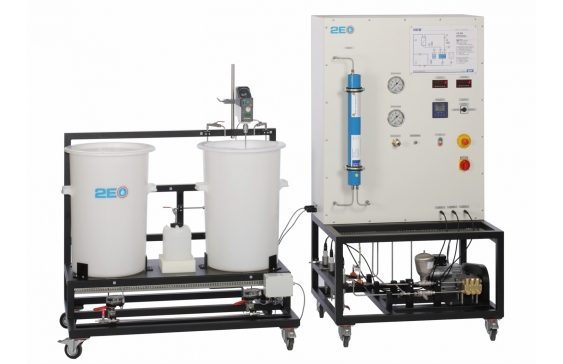CE 530 Reverse osmosis

This trainer has been developed in cooperation with the Institute for Thermal Process Engineering at the TU Hamburg-Harburg. A solution of NaCl in a defined concentration (up to 4% max.) is mixed in a tank complete with a stirring machine. A pump delivers the solution to the spiral wound membrane module. The pump generates the necessary pressure for separation.
The spiral wound membrane module consists of multiple membrane envelopes. A membrane envelope is made up of two membranes with a porous spacer between them. The membrane envelope is sealed on three sides and on its fourth, open, side is connected to the perforated permeate collecting tube. There are other spacers between the envelopes to ensure axial flow of the salt solution. The spacers together with the membrane envelopes are wound spirally around the permeate collecting tube. The salt solution arrives at the front face of the module and flows axially between the envelopes. The semi-permeable membrane is permeable to water (permeate) but not to dissolved NaCl. The applied pressure forces the water through the membrane into the envelopes. In the envelopes the water flows spirally towards the permeate collecting tube and exits the module in an axial direction. As a result of the water being removed, the solution is concentrated as it travels through the module. It exits the module as retentate and is returned to the raw water tank.
The permeate is collected in a separate tank. Another tank containing distilled water is provided to flush through the spiral wound membrane module.
The pressure and flow rate can be adjusted by valves. In order to check the success of the separation, salt concentrations in the raw water, retentate and permeate are recorded by measuring the respective conductivity values.
- membrane separation process for obtaining solvent from a salt solution
- spiral wound membrane module for separation
- example application: sea water desalination
Spiral wound membrane module
- active area: 1,2m2
- raw water flow rate: max. 23L/min
- length: approx. 500mm
- diameter: approx. 60mm
Piston pump
- max. flow rate: approx. 425L/h
- max. head: approx. 700m
Max. operating pressure: 48bar
Stirring machine
- power consumption: 140W
- speed: 30…1000min-1
Tanks
- raw water (salt solution): approx. 110L
- distilled water: approx. 110L
- permeate: approx. 5L
Measuring ranges
- retentate flow rate: 0,2…6,0L/min
- permeate flow rate: 0,05…1,8L/min
- temperature: 3x 0…50°C
- pressure: 2x 0…120bar
- conductivity: 3x 0…200mS/cm
230V, 50Hz, 1 phase
230V, 60Hz, 1 phase
120V, 60Hz, 1 phase
- removal of solvent from a salt solution using reverse osmosis
- polyamide spiral wound membrane module
- piston pump with pulsation damper for pressure generation
- overflow valve to adjust the pressure upstream of the membrane module
- valve to adjust the retentate flow rate
- raw water tank with stirring machine to prepare a salt solution of up to 4% max.
- tank for distilled water to flush through the spiral wound membrane module
- tank to collect the permeate
- safety cutout to protect the pump against dry running
- assembly, cleaning and conservation of membrane modules
- fundamental principle of reverse osmosis
- Van’t Hoff’s law
- permeate flow rate and retention dependent on
- pressure
- salt concentration in raw water
- yield
- determination of diffusion coefficients

